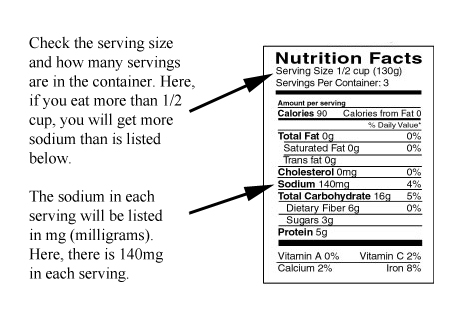Low-Salt Eating When You Have Cirrhosis
When you have cirrhosis, you should limit how much salt you have. On a food label, salt will be called sodium. Salt goes by other names: baking soda, MSG or monosodium glutamate, or any other name with “sodium” in it.
How much salt can I have?
You should not have more than 2,000mg in a day. 2,000mg is about the same as one teaspoon.
How do I know how much salt is in my food?
Read food labels. Here is an example.
Check the food label even if the package says “sodium free” or “reduced sodium.” These foods likely have some salt in them.
How should I keep track of how much salt I have?
First, find out how much salt (sodium) is in your food. Next, add up how much you have each time you eat. Stop eating salt before you reach your 2,000mg daily limit.

What will happen if I eat too much salt?
-
You will get painful swelling in your legs.
-
Fluid could start to build up in your belly. This problem is called ascites.
-
Fluid can build up around your lungs making it hard to breath.
-
If you do not control your salt, your water pills could harm your kidneys.
What can I do at home?
-
Cook with herbs and seasonings that have no salt.
-
Take the salt shaker off the table.
-
Eat lots of fresh fruits and veggies.
-
Try to avoid frozen, canned or boxed foods.
-
Avoid salted or processed meats like lunch meat, ham, bologna, bacon, or sausage.
Can I eat out?
At home, you can control how much salt is in your food. But it is OK to eat out once in a while if you follow these tips:
-
Do not add salt to your food.
-
Ask them to cook your meal with no salt or MSG.
-
Avoid salad dressings. Use oil and vinegar instead.
-
Stay away from fast food and pizza.
-
Choose meals that are steamed, grilled or baked. Fried or breaded foods may have lots of salt.